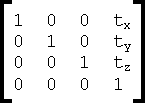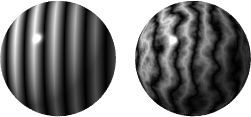
Home | Raytracing Reference | Help
A texture is a pattern of varying appearance properties applied to a surface. Usually, a texture defines the colour pattern on a surface, but the term can be extended to any procedure or image that defines the nature of the surface (i.e, colour, roughness, transparency etc) at various points. Textures may be of two types. Firstly, a texture may be an image that is mapped onto the surface, e.g. a bitmap image of a brick wall applied to a block makes the latter look as if it is made of bricks. Secondly, a texture may be a procedure or function that mathematically generates the surface properties at various points. Textures may be 2-D, as in image maps and in procedures which are functions of uv coordinates, or 3-D, as in solid textures which are defined for all points in space and allow objects to appear as if they have been "carved out" of a solid material.

A torus is a doughnut shaped object. It may be thought of as a tube bent into a closed circular ring. It is a quartic: when centered at the origin it has the equation

where R is the radius of the ring and r is the radius of the tube.
A transformation is a process that changes a quantity in some way. This is a very general definition, so depending on the context, narrower definitions are used. In computer graphics, the most common meaning of transformation is a procedure that changes the position, shape, size or orientation of an object in some way. Examples are translation, rotation and scaling. Projection transformations are also frequently encountered.
See also: matrix
Translation is the process by which an object's position is changed without affecting its shape, size or orientation. The usual method of specifying translations is in terms of offsets along the different coordinate axes. For instance, given the offset vector (tx, ty, tz), a translation procedure will shift an object by tx units in the x-direction, ty units in the y-direction and tz units in the z-direction. The corresponding matrix representation is

Objects may be completely opaque, but they are seldom completely transparent. The amount of light transmitted through a transparent medium is usually some fraction of the original amount. The ratio of the intensity of the emergent light to that of the incident light is a property of the medium and is known as "transmittivity". Many renderers, for simplicity, assign a constant value to the transmittivity of an object, but actually the transmittivity varies according to the angle of incidence, the refractive index of the medium, the distance travelled through the medium and other factors. The Fresnel equation is commonly used as an advanced model for calculating transmittivity values.
A triangle is a polygon having 3 edges and 3 vertices. A triangle has many useful properties which make it ideal for 3-D modelling. For instance, it is always convex (i.e. interior angles at the vertices are less than 180 degrees) and there are fast ways to check if a point is inside a triangle or not. Also, any 3 non-collinear points are sufficient to define a triangle: with quadrilaterals and higher polygons, there is always the danger that the points chosen may not all lie on the same plane. Mapping and interpolation calculations are easy. For these reasons and others, nearly all mesh structures (the most widely used object represention method) employ triangles. Indeed, most modern graphics hardware handles nothing but triangles. The study of triangles forms an important branch of mathematics, known as trigonometry.
Turbulence is a noise function defined over all points in 3-D space. It usually returns a set of random offsets in the different coordinate directions. The addition of turbulence introduces random displacement patterns. For instance, let the function F(x, y, z) return the colour value C at the point (x, y, z) according to some well-defined pattern. We have a turbulence function T(x, y, z) which returns a set of offsets (tx, ty, tz). We may now construct a turbulent function F' which returns the value C' = F(x+tx, y+ty, z+tz). This function resembles F, but has interesting, disordered variations. In other words, the turbulence function says: instead of returning the value at a point in space, move some distance away randomly and return the value at the new position.
